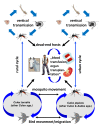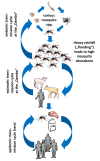Emergence of zoonotic arboviruses by animal trade and migration
- PMID: 20377873
- PMCID: PMC2868497
- DOI: 10.1186/1756-3305-3-35
Emergence of zoonotic arboviruses by animal trade and migration
Abstract
Arboviruses are transmitted in nature exclusively or to a major extend by arthropods. They belong to the most important viruses invading new areas in the world and their occurrence is strongly influenced by climatic changes due to the life cycle of the transmitting vectors. Several arboviruses have emerged in new regions of the world during the last years, like West Nile virus (WNV) in the Americas, Usutu virus (USUV) in Central Europe, or Rift Valley fever virus (RVFV) in the Arabian Peninsula. In most instances the ways of introduction of arboviruses into new regions are not known. Infections acquired during stays in the tropics and subtropics are diagnosed with increasing frequency in travellers returning from tropical countries, but interestingly no attention is paid on accompanying pet animals or the hematophagous ectoparasites that may still be attached to them. Here we outline the known ecology of the mosquito-borne equine encephalitis viruses (WEEV, EEEV, and VEEV), WNV, USUV, RVFV, and Japanese Encephalitis virus, as well as Tick-Borne Encephalitis virus and its North American counterpart Powassan virus, and will discuss the most likely mode that these viruses could expand their respective geographical range. All these viruses have a different epidemiology as different vector species, reservoir hosts and virus types have adapted to promiscuous and robust or rather very fine-balanced transmission cycles. Consequently, these viruses will behave differently with regard to the requirements needed to establish new endemic foci outside their original geographical ranges. Hence, emphasis is given on animal trade and suitable ecologic conditions, including competent vectors and vertebrate hosts.
Figures





Similar articles
-
Arboviruses pathogenic for domestic and wild animals.Adv Virus Res. 2014;89:201-75. doi: 10.1016/B978-0-12-800172-1.00005-7. Adv Virus Res. 2014. PMID: 24751197
-
Risk factors associated with sustained circulation of six zoonotic arboviruses: a systematic review for selection of surveillance sites in non-endemic areas.Parasit Vectors. 2019 May 27;12(1):265. doi: 10.1186/s13071-019-3515-7. Parasit Vectors. 2019. PMID: 31133059 Free PMC article.
-
Potential Sympatric Vectors and Mammalian Hosts of Venezuelan Equine Encephalitis Virus in Southern Mexico.J Wildl Dis. 2017 Jul;53(3):657-661. doi: 10.7589/2016-11-249. Epub 2017 Apr 6. J Wildl Dis. 2017. PMID: 28384059
-
Host range, amplification and arboviral disease emergence.Arch Virol Suppl. 2005;(19):33-44. doi: 10.1007/3-211-29981-5_4. Arch Virol Suppl. 2005. PMID: 16358422 Review.
-
A review of West Nile and Usutu virus co-circulation in Europe: how much do transmission cycles overlap?Trans R Soc Trop Med Hyg. 2015 Oct;109(10):609-18. doi: 10.1093/trstmh/trv066. Epub 2015 Aug 17. Trans R Soc Trop Med Hyg. 2015. PMID: 26286946 Review.
Cited by
-
Understanding the Transmission Dynamics of the Chikungunya Virus in Africa.Pathogens. 2024 Jul 22;13(7):605. doi: 10.3390/pathogens13070605. Pathogens. 2024. PMID: 39057831 Free PMC article. Review.
-
Role of inflammatory cytokine burst in neuro-invasion of Japanese Encephalitis virus infection: an immunotherapeutic approaches.J Neurovirol. 2024 Jun;30(3):251-265. doi: 10.1007/s13365-024-01212-z. Epub 2024 Jun 6. J Neurovirol. 2024. PMID: 38842651 Review.
-
Potential zoonotic spillover at the human-animal interface: A mini-review.Vet World. 2024 Feb;17(2):289-302. doi: 10.14202/vetworld.2024.289-302. Epub 2024 Feb 7. Vet World. 2024. PMID: 38595670 Free PMC article. Review.
-
Diversity and prevalence of zoonotic infections at the animal-human interface of primate trafficking in Peru.PLoS One. 2024 Feb 7;19(2):e0287893. doi: 10.1371/journal.pone.0287893. eCollection 2024. PLoS One. 2024. PMID: 38324542 Free PMC article.
-
Molecular Detection and Phylogenetic Analysis of Tick-Borne Encephalitis Virus from Ticks Collected from Cattle in Kyrgyzstan, 2023.Viruses. 2024 Jan 11;16(1):107. doi: 10.3390/v16010107. Viruses. 2024. PMID: 38257807 Free PMC article.
References
-
- Bengis RG, Leighton FA, Fischer JR, Artois M, Mörner T, Tate CM. The role of wildlife in emerging and re-emerging zoonoses. Rev Sci Tech Off Int Epiz. 2004;23:497–511. - PubMed
-
- World Health Organization. Arthropod-borne and rodent-borne viral diseases. Report of a WHO Scientific group. Wld Hlth Tech Rep Ser. 1985;719:1–114. - PubMed
LinkOut - more resources
Full Text Sources

